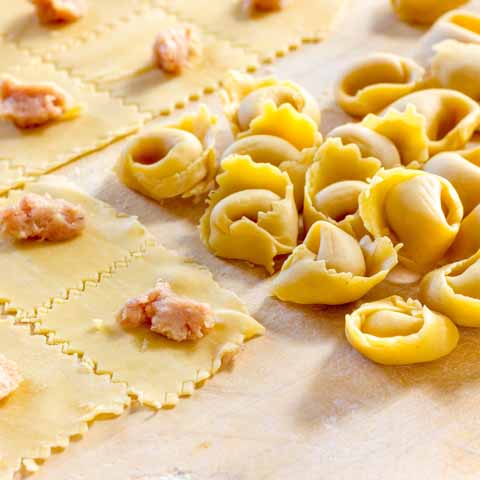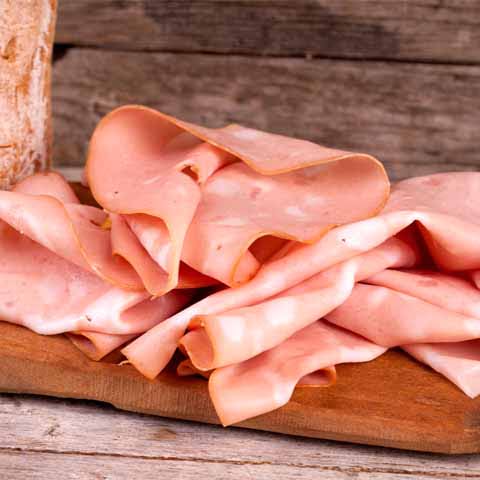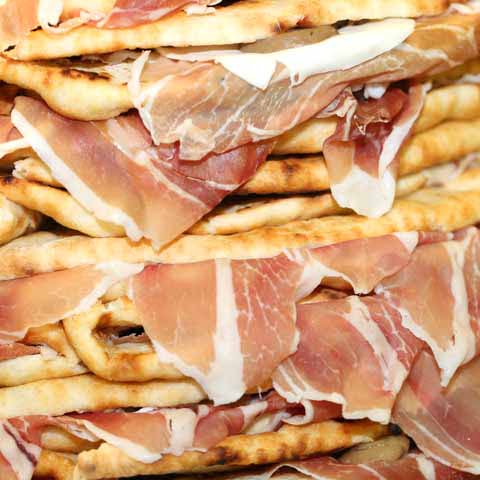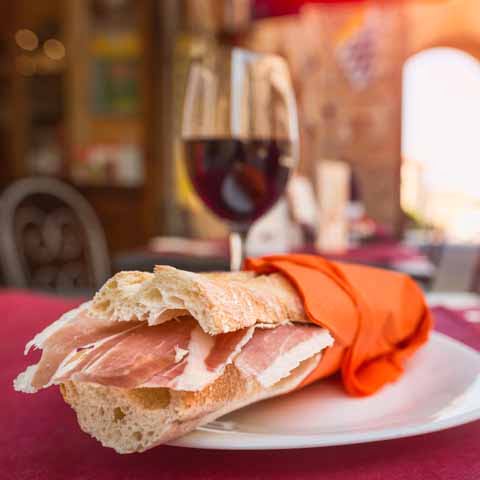Deep in the heart of Northern Italy is the city of Bologna which is nicknamed “La grassa”, or “the fat one”, due to the city’s rich and highly praised gastronomy. While the entire region of Emilia-Romagna is renowned for its culinary products, Bologna in particular is celebrated for its unique dishes that have become emblematic of Italian cuisine around the world. Bologna’s strong culinary ties have even led it to be called “The City of Food”. With a cuisine heavily based on tradition, many of Bologna’s most famous dishes, such as tagliatelle, ragù bolognese, and lasagne verdi al ragù have an official recipe designated by the Accademia italiana della cucina (The Italian Cooking Academy). The best advice for dining in Bologna is simply to pace yourself and linger over the meal so you have time to indulge in Italy’s finest.
APPETIZERS
As in many places in Italy, the meal begins with an assortment of locally made cured meats and cheeses. The cured meats are typically referred to as affettati misti (mixed cured meats).
In Bologna, mortadella, specifically Mortadella Bologna, is king. Invented in Bologna with origins in the seventeenth century, this cold cut consists of pork meat, pork fat cubes, and spices, such as black pepper and sometimes pistachios. Much more flavorful than its international derivative, boloney, mortadella is finely ground then slowly heat-cured between 8 and 26 hours (depending on size). When sliced, mortadella is fragrant with a bright pink color and a delicate taste. Mortadella may also be served as a mousse, known as spuma di mortadella, which is made by mixing ground mortadella, ricotta, and Parmigiano-Reggiano into a paste then adding cream and blending it until a foam forms. Spuma di mortadella is typically served on slices of toasted bread.
After mortadella, prosciutto crudo is another common cured meat enjoyed throughout Bologna. The prosciutto crudo served in Bologna may come from nearby Parma, and in this case is known as prosciutto di Parma. The prosciutto featured in Bologna’s appetizers may also be made elsewhere in the Emilia-Romagna region and in this case it is simply called prosciutto crudo. Prosciutto di Parma is considered to be among the best quality prosciutto in all of Italy, though in Bologna it is not uncommon to find prosciutto crudo made in other parts of Emilia-Romagna as well. In either case, this thinly sliced dry-cured ham is a real treat no matter what part of the region it comes from. A defining characteristic of all prosciutto crudo is that it is served uncooked, as opposed to prosciutto cotto, which is cooked (steamed) and served cold like other cured meats. Generally speaking, production of prosciutto crudo in the metropolitan area of Bologna is varied and of high quality. In addition to prosciutto di Parma, in Bologna’s restaurants it is also possible to find prosciutto crudo from Modena, which has a sweeter taste, as well as prosciutto crudo di Mora Romagnola, which is highly revered small-batch prosciutto made only from Mora Romagnola wild pigs.
In addition to mortadella and prosciutto, another cured meat typically served as part of an appetizer in Bologna is salame. Found throughout Italy, salame consists of ground meat (usually pork) and fat that is dry-aged. Depending on where the salame is made, a variety of spices may be added to the meat such as garlic, black pepper, or fennel. In Bologna, salame is sliced thin and served alongside other cured meats as part of the affettati misti.
Typically accompanying the meats is an assortment of local cheeses, with one of the most popular being Parmigiano-Reggiano. Hailing from the nearby city of Parma, Parmigiano-Reggiano is the quintessential aged Italian cheese and is nicknamed the “King of Cheeses”. Made from cow’s milk, Parmigiano-Reggiano is a hard cheese with a rich flavor developed over an aging process of 12 to 36 months. In addition to being produced in the province of Parma, Parmigiano-Reggiano is also produced in the provinces of Reggio Emilia, Modena, Mantova (to the right of the Po River), and in the metropolitan area of Bologna to the left of the Reno River. With its distinct flavor, Parmigiano-Reggiano makes for an excellent appetizer, though of course it is also delicious grated over pasta as well as incorporated into a risotto or a soup.
In the area of Bologna on the other side of the Reno River, another iconic Italian cheese is produced: Grana Padano. Considered to be the most popular cheese in the country, Grana Padano is a hard cheese made using cow’s milk that is aged for 8 to 20 months. Produced throughout the area of the Po River Valley, Grana Padano is made in parts of Emilia-Romagna, but it is not unique to the region and is also made in Piedmont, Lombardy, Trentino, and Veneto. While Parmigiano-Reggiano is more emblematic of the region, Grana Padano is commonly featured in appetizers throughout the city as well.
Another popular regional cheese is squacquerone. Though this cheese is originally from the hills of Romagna, an area that borders the metropolitan zone of Bologna, squacquerone can now be enjoyed throughout Bologna as well. This fresh and creamy cheese made from cow’s milk provides a nice contrast to the firm aged cheeses that are prevalent in the area, imparting a nice balance when it is featured in a local appetizer with other cheeses.
Last is the area’s version of pecorino, which originates in the hills surrounding Bologna. An aged cheese made using sheep’s milk, pecorino can be found throughout Italy with notable regional varieties from Sardinia, Lazio, and Tuscany. The pecorino made in the area around Bologna is aged for approximately 30 days, giving it a softer consistency and sweeter taste compared to other regional varieties.
In Bologna, no matter what cured meats and cheeses are served, no antipasto is complete without crescentine. These delicious treats are made with flour, brewer’s yeast, water, and salt. The ingredients are worked into a dough, cut into rectangular or rhomboid strips, and then fried. The yeast causes the dough to puff up as it fries, giving crescentine their characteristic shape. Found throughout the Emilia-Romagna region (sometimes under other names, such as gnocco fritto), crescentine are typically served with cured meats though they can also be enjoyed on their own.
In addition to crescentine, in Bologna cured meats and cheeses may also be served with tigelle, which originate from Modena where they are called crescente or crescentine. In Bologna, a tigella refers to a round bread with a crisp exterior and soft interior. Together with crescentine, tigelle may accompany cured meats in Bologna or they may be enjoyed with a spread made from local ingredients (such as lard, fresh herbs, garlic, and cheeses).
FIRST COURSE
Pasta is the king of the castle when it comes to first course options in Bologna. The city serves a wide variety of pasta shapes and fresh pasta made with eggs takes centerstage.
Foremost among the local pastas in Bologna is tagliatelle. Originating in the Emilia area, this pasta shape is emblematic of Emilia-Romagna’s cuisine as well as that of Bologna. A long pasta shape made by cutting (“tagliare” in Italian, hence the name tagliatelle) sheets of pasta dough, tagliatelle are wide and flat. Traditionally, this fresh pasta is made by hand using flour and eggs. The classic way to serve tagliatelle in Bologna is with ragù bolognese, a sauce made from ground beef.
The traditional preparation of ragù bolognese begins with pancetta, which is gently pan-fried. Then butter is added followed by finely chopped celery, carrot, and onion. These ingredients are sauteed until soft and fragrant then the ground beef is added. When the meat is browned, red wine is added then allowed to evaporate completely. At this point, a small amount of tomato puree is added and the mixture is allowed to cook slowly for a minimum of 2 to 3 hours, adding broth or water as needed to keep the sauce moist. At the end of the cooking time, a small amount of milk is added to impart a creaminess to the dish and balance the acidity of the tomato.
Ragù bolognese is served with fresh pasta, specifically tagliatelle, in Bologna, though it is also featured in lasagne al forno and in some cases it may be served with polenta.
After tagliatelle, tortellini are perhaps the second most popular type of pasta that originated Bologna. Like tagliatelle, tortellini fall under the category of fresh pasta and their dough features flour and eggs. The pasta itself is made by laying out a thin sheet of dough that is cut into squares then filled and shaped by hand. Tortellini differ from other stuffed pastas because they have a ring shape with a hole in the bottom half. The traditional filling for tortellini in Bologna consists of pork loin, prosciutto crudo, mortadella, Parmigiano-Reggiano, eggs, and nutmeg. Tortellini are traditionally served in a rich beef broth and this preparation is called tortellini in brodo. Though it is less traditional, in Bologna it is not uncommon to find tortellini served with ragù bolognese as well. No matter how they are served, tortellini must always be cooked in boiling broth, not water, as water is known to dilute the rich flavors of the filling.
In addition to the traditional meat filling, a larger version of tortellini, called tortelloni, may be filled with ricotta cheese. In this case, the traditional way to serve tortelloni is with butter and sage or with tomato sauce. There is also a variation of tortelloni called balanzoni, which have the same shape as tortelloni but they have a distinctive green color because spinach is added to the dough. Balanzoni are typically filled with ricotta, mortadella, and Parmigiano-Reggiano and are served simply with butter and sage.
Another fresh pasta that is popular in Bologna is known as passatelli, though this dish differs slightly from the previously mentioned pastas. A traditional dish in Romagna and the metropolitan area of Bologna, passatelli are made from a dough of breadcrumbs, Parmigiano-Reggiano, eggs, and nutmeg. The pasta is shaped by pushing the dough through a special instrument that makes long cylindrical strips that are cut then boiled in cappon, chicken, or beef broth. Outside of Emilia-Romagna, passatelli are also a staple in the cuisine of the province of Pesaro and Urbino in the Marche region as well as the province of Perugia in the Umbria region.
Gramigna con la salsiccia is another local favorite. Though not as famous outside of the region as other pastas, this dish is considered to be a specialty of the Emilia area. Gramigna is another fresh pasta made with egg and it has a thin, tube-like shape that is curled. Gramigna con la salsiccia refers to gramigna specifically served with sausage. Cream or tomato sauce may be added to the sausage. In some restaurants, the gramigna pasta shape may be served in other ways, such as with ragù bolognese.
Fresh pasta is also featured in an Emilia-Romagna dish that is known as a staple of Italian cuisine throughout the world: lasagne al forno. This baked pasta dish can be found in many regions of Italy, such as Campania, each with its own spin. The version of this dish that originated in Bologna and that can be enjoyed throughout Emilia-Romagna is called lasagne verdi alla bolognese featuring fresh pasta made with eggs. For this dish, spinach is added to the pasta dough, giving it a green color. Once the dough is ready, it is shaped into thin sheets, which are assembled with alternating layers of ragù bolognese, bechamel, and Parmigiano-Reggiano. In the region of Emilia-Romagna, this traditional preparation may be referred to simply as lasagne or lasagne al forno, though in other parts of Italy the full name of lasagne verdi alla bolognese is typically used to differentiate the dish from other regional variations. Outside of Bologna, lasagne al forno may feature the ragù bolognese with normal egg pasta minus the spinach.
One common soup that may be enjoyed as a first course in Bologna is zuppa imperiale. The soup features cubes of dough that are made using semolina, eggs, Parmigiano-Reggiano, mortadella, butter, and nutmeg. The ingredients are worked into a dough that is spread out and baked. Afterwards, the dough is cut into cubes and served in capon broth.
SECOND COURSE
As you might have noticed with the previous courses, meat features prevalently in Bolognese cuisine, and the second course, which in Italy is traditionally the course dedicated to meat-based dishes, is no exception.
A typical dish in Bologna, bollito misto (also known as gran bollito alla bolognese) is a savory choice for the second course. Bollito misto, a soup made from a mixture of simmered meats, is common throughout the area of the Po River Valley, most notably in Piedmont, but also in Lombardy and in Veneto. In Bologna specifically, this dish consists of cuts of beef, pork, chicken, and veal. A variety of parts are used including tongue as well as cotechino, a type of pork sausage. In Bologna this dish is served with mustard or salsa verde, a sauce composed of parsley, capers, anchovies, garlic, pickled onions, and softened breadcrumbs.
Cotoletta alla bolognese is a popular veal based second course. Cotoletta in general is a meat cutlet that can be prepared in various ways throughout Italy (such as a breaded and fried, known as cotoletta alla milanese, which is a typical dish in Milan). Cotoletta alla bolognese, also called Petroniana, differs from cotolette in other parts of Italy due to the use of ingredients typical to the area, namely prosciutto crudo and Parmigiano-Reggiano. In Bologna, the dish consists of a veal or chicken cutlet that is coated with eggs, Parmigiano-Reggiano, and breadcrumbs then fried in butter. Afterwards, the cutlet is covered in prosciutto crudo and Parmigiano-Reggiano. A small amount of beef broth is added to the pan then the pan is covered and heated gently until the cheese has melted. In some cases, the dish may be topped with truffle shavings from the Apennines surrounding Bologna. Cotoletta alla bolognese may also be served with a small amount of tomato sauce.
Gran fritto misto alla bolognese is almost like a buffet of various fried foods ranging from meat and cheese to vegetables and sweets. Some of the showstoppers of this dish include fried lamb ribs, fried mortadella, fried mozzarella, fried zucchini, fried eggplant, fried custard, fried ricotta, and apple fritters. Especially with this dish, the more you share, the more room you will have to try a bite of everything.
Polpette alla bolognese are meatballs made with beef, veal, mortadella, breadcrumbs, nutmeg, and Parmigiano-Reggiano. The meatballs are covered in flour, pan fried, then cooked in a tomato sauce with peas.
Another beef dish is polpettone alla bolognese, which is a local dish similar to meatloaf. In Bologna, this dish is made with ground beef, prosciutto crudo or mortadella, Parmigiano-Reggiano, breadcrumbs, and eggs.
Galantina di pollo is a complex dish and in Bologna it may be purchased from local butcher shops then cooked at home. The dish consists of boneless cuts of chicken that are stuffed with sausage, mortadella, pistachios, and olives and shaped into a roll. It is cooked in broth over low heat for at least an hour and a half. The dish is sliced and served cold with vegetables.
SIDE DISHES
Side dishes in Bologna tend to follow simple recipes that are meant to complement the first and second courses. As in other parts of Italy, local, in-season vegetables prepared in a variety of ways, such as steamed, grilled, or sauteed, may be served as side dishes in Bologna. Two protected crops that are grown around Bologna include the Patata di Bologna, a white potato used to make potato puree, and the Asparago verde di Altedo, an asparagus with a delicate taste and tender consistency.
One recipe that is typical of Bologna is called friggione. The steps to make this historic sauce are simple, though many hours are required to make it correctly. First, onions must be marinated for at least 4 hours and then cooked in lard for at least 2 hours. Afterwards, peeled tomatoes are added and the mixture is cooked over low heat for another hour and a half. The resulting sauce can be spread on toasted bread, served with meat, or served over polenta.
Another common sauce is salsa verde, made with parsley, capers, anchovies, garlic, pickled onions, and softened breadcrumbs. As mentioned above, the sauce may be served with gran bollito alla bolognese or it can also be served with fish.
STREET FOOD
One of the most popular street foods in the area is crescente, a local type of focaccia or flatbread. Native to the Emilia area, the classic recipe for crescente features flour, salt, lard, sugar, yeast, and water. What makes crescente stand out from focaccia produced in other parts of Italy is that cured meats such as mortadella, prosciutto, or pancetta are mixed into the dough prior to baking. This delicious flatbread is perfect to take on the go while exploring Bologna’s city center and is best enjoyed fresh out of the oven.
Originating in the Romagna area, but now found throughout the Emilia-Romagna region, the traditional piadina romagnola is another delicious street food to try when in Bologna. This simple yet delicious flatbread consists of a thin piece of dough made from flour, lard or olive oil, salt, and water that is filled with local meats, cheeses, and/or vegetables then heated up on a griddle. Enjoyed by locals as a snack, the piadina’s portability makes it the perfect street food or a good option for a quick lunch on the go. It can also be served on a plate during a sit-down lunch and, in this case, it is traditionally cut into 4 wedges (or even 6 to 8 wedges depending on the size). Typical fillings in the area include prosciutto crudo, salame, coppa, scquacquerone cheese, porchetta, or grilled sausage.
DESSERT
A sinfully delicious dessert is never far away when dining in Bologna. While you can expect to find some of the Italian staples such as gelato for a sweet treat, Bologna has a few unique options you won’t want to miss.
Torta di Riso or Torta degli Addobbi is a traditional sweet rice cake typically served during the Festa degli Addobbi. This time-honored dessert whose origins can be traced back to the early eighteenth century is generally comprised of arborio rice, sugar, eggs, milk, chopped almonds, candied citron, lemon peel, and liquor. It is served cut into small squares and is best enjoyed in the company of good friends and family.
Zuppa Inglese is an older traditional dish and one of the best-known desserts in the city. It most closely resembles an English trifle and consists of a combination of custard, sponge cake soaked in Alchermes and Rosolio liqueur, and cocoa powder. This sweet can be enjoyed in other parts of Emilia-Romagna as well as other regions of Italy including Lazio, Marche, Tuscany, Abruzzo, and Umbria. In Bologna, the soaked sponge cake may be replaced with soaked ladyfingers.
Certosino di Bologna is a round cake served often during the Christmas holiday. The cake is a mixture of honey, dark chocolate, cocoa powder, pine nuts, almonds, cinnamon, candied fruits, and fruit jam. It is said that this particular cake tastes best after it has sat for several days. Historically known as pan speziale, the original recipe is said to date back to the Middle Ages. A similar cake also enjoyed in Bologna during Christmastime is called panone, which does not have candied fruits, but rather dried figs, raisins, and a pinch of coffee.
Raviole bolognesi are oven baked cookies that resemble ravioli and were traditionally prepared in March for the Feast of St. Joseph, but now can be purchased in Bologna throughout the year. Raviole bolognesi are made from a sweet pastry dough that is filled with mostarda bolognese, a preserve present in other parts of Italy as well, but in Bologna it consists of quinces, plums, and orange peels. In addition to the classic recipe, raviolie bolognesi can be filled with plum or apricot jam. They can also be dusted with powdered sugar or brushed with Alchermes liqueur and covered with caster sugar.
Another sweet treat, pinza bolognese, was traditionally tied to the Christmas season, but now is enjoyed year-round in Bologna. To make pinza bolognese, a sweet dough is formed then filled with mostarda bolognese and rolled. Like the raviole bolognesi, pinza bolognese can alternatively be stuffed with a simple plum jam as well.
Also worth trying are sabadoni, which are originally from Romagna. Recipes can vary from family to family, but typically sabadoni consist of sweet dough formed into a rectangular shape and filled with boiled chestnuts, a jam made from pears and quinces, and lemon zest. Sabadoni may be baked or fried, but in either case the final step is to submerge them in saba, a syrup made from concentrated grape must. Sabadoni may also be topped with powdered sugar.
Crema di mascarpone is a very simple dessert that is enjoyed in Bologna as well as other parts of Italy. Made with only mascarpone, eggs, sugar, and rum, crema di mascarpone is a rich cream that may be served with a sprinkle of cocoa powder.
WINES
While there are a number of fabulous wines from the Emilia-Romagna region such as Gutturnio, Malvasia, Bonarda, Barbera, Lambrusco, Albana, and Sangiovese, the showstopper in Bologna is Pignoletto.
Produced in the hills surrounding Bologna (Colli Bolognesi) Pignoletto is a white wine that goes well with Italian appetizers, tortellini in brodo, and seafood. This delicate wine has a bit of tartness that balances out some of the fruity taste, making it a wonderful complement to the hearty and savory dishes of the city of Bologna.
After a day of traveling through the city, come to the table, pull out a chair, and feed your heart and soul with the treasured cuisine of Bologna. The food tells a rich tale of tradition and culture, inviting you to be a part of the story.
Travel Guides
The Emilia Romagna Region of Italy
The Cities of Emilia Romagna, Italy














